Brand Equity's Impact on Competitive Advantage in FMCG
VerifiedAdded on 2020/03/07
|9
|1530
|112
Report
AI Summary
This report examines the critical role of brand equity in achieving a competitive advantage within the Fast-Moving Consumer Goods (FMCG) industry. It begins with a literature review, defining brand equity and its models, and then explores the relationship between brand awareness, market penetration, and competitive strategies. The report analyzes how brand equity contributes to cost leadership, differentiation, and focus strategies, providing examples and insights. It also discusses the impact of brand equity on market position and profitability. The report concludes by identifying gaps in existing research, such as the reliability of information from various sources and the need for more comprehensive data. It highlights the importance of strong brand equity for long-term success in the competitive FMCG market.
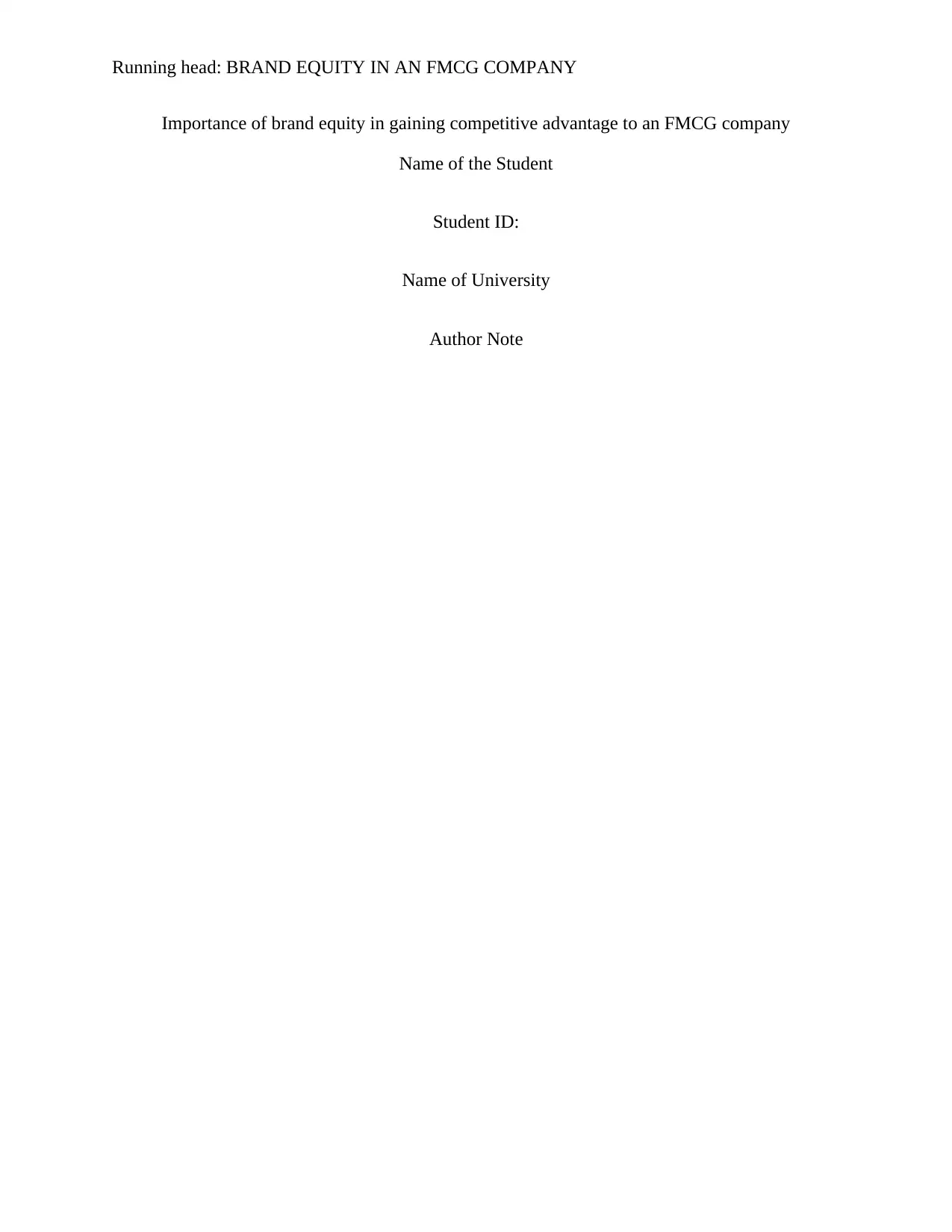
Running head: BRAND EQUITY IN AN FMCG COMPANY
Importance of brand equity in gaining competitive advantage to an FMCG company
Name of the Student
Student ID:
Name of University
Author Note
Importance of brand equity in gaining competitive advantage to an FMCG company
Name of the Student
Student ID:
Name of University
Author Note
Paraphrase This Document
Need a fresh take? Get an instant paraphrase of this document with our AI Paraphraser
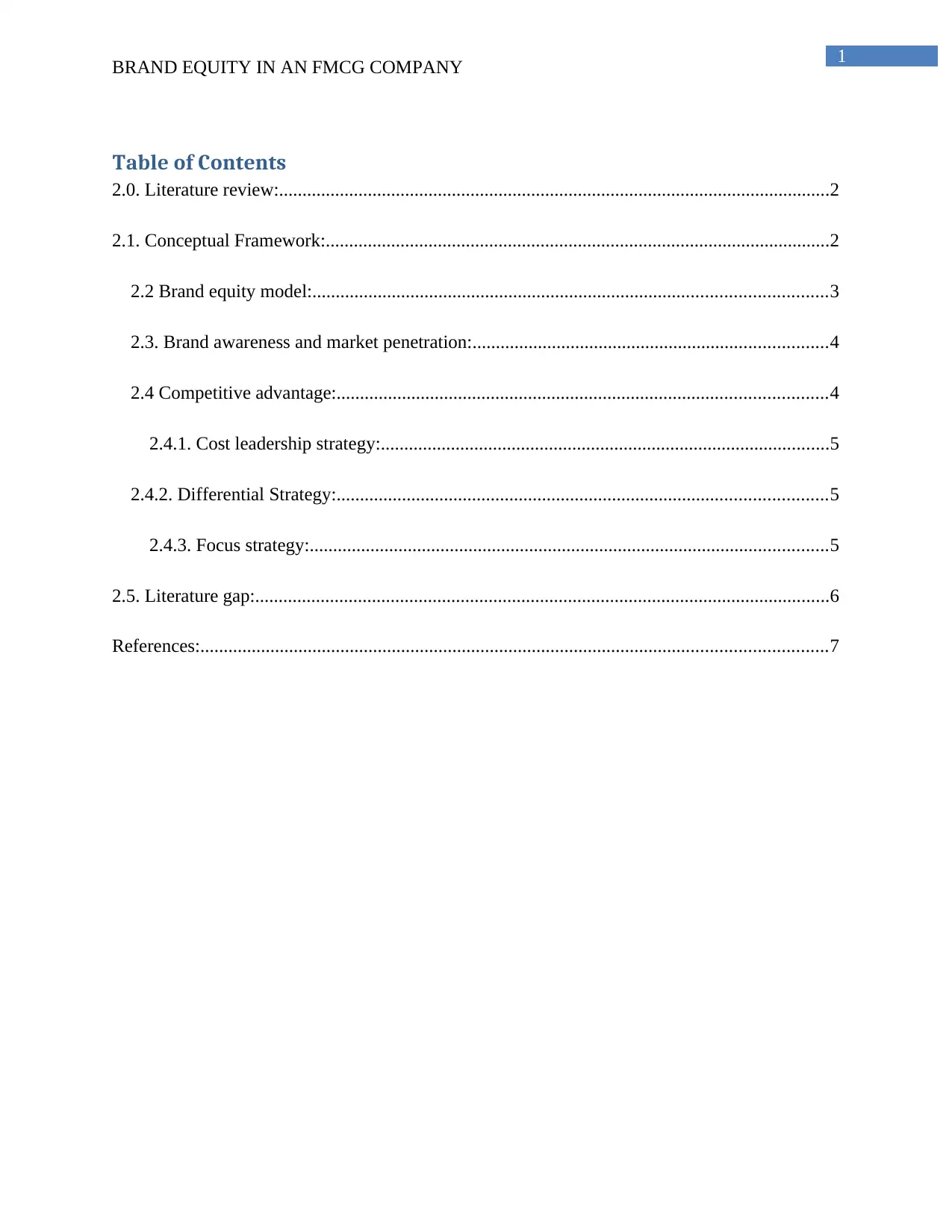
1
BRAND EQUITY IN AN FMCG COMPANY
Table of Contents
2.0. Literature review:......................................................................................................................2
2.1. Conceptual Framework:............................................................................................................2
2.2 Brand equity model:..............................................................................................................3
2.3. Brand awareness and market penetration:............................................................................4
2.4 Competitive advantage:.........................................................................................................4
2.4.1. Cost leadership strategy:................................................................................................5
2.4.2. Differential Strategy:.........................................................................................................5
2.4.3. Focus strategy:...............................................................................................................5
2.5. Literature gap:...........................................................................................................................6
References:......................................................................................................................................7
BRAND EQUITY IN AN FMCG COMPANY
Table of Contents
2.0. Literature review:......................................................................................................................2
2.1. Conceptual Framework:............................................................................................................2
2.2 Brand equity model:..............................................................................................................3
2.3. Brand awareness and market penetration:............................................................................4
2.4 Competitive advantage:.........................................................................................................4
2.4.1. Cost leadership strategy:................................................................................................5
2.4.2. Differential Strategy:.........................................................................................................5
2.4.3. Focus strategy:...............................................................................................................5
2.5. Literature gap:...........................................................................................................................6
References:......................................................................................................................................7
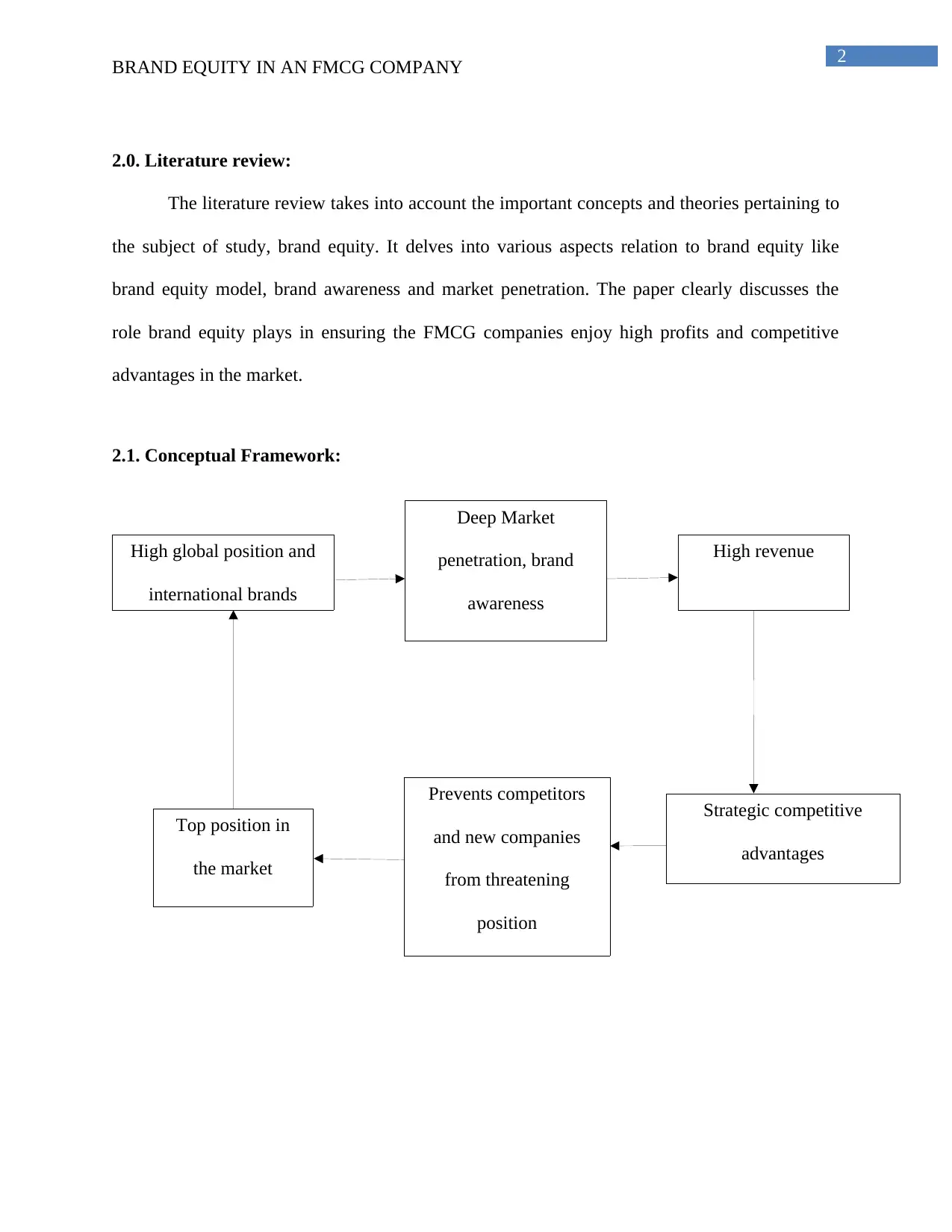
2
BRAND EQUITY IN AN FMCG COMPANY
2.0. Literature review:
The literature review takes into account the important concepts and theories pertaining to
the subject of study, brand equity. It delves into various aspects relation to brand equity like
brand equity model, brand awareness and market penetration. The paper clearly discusses the
role brand equity plays in ensuring the FMCG companies enjoy high profits and competitive
advantages in the market.
2.1. Conceptual Framework:
High global position and
international brands
Deep Market
penetration, brand
awareness
High revenue
Top position in
the market
Prevents competitors
and new companies
from threatening
position
Strategic competitive
advantages
BRAND EQUITY IN AN FMCG COMPANY
2.0. Literature review:
The literature review takes into account the important concepts and theories pertaining to
the subject of study, brand equity. It delves into various aspects relation to brand equity like
brand equity model, brand awareness and market penetration. The paper clearly discusses the
role brand equity plays in ensuring the FMCG companies enjoy high profits and competitive
advantages in the market.
2.1. Conceptual Framework:
High global position and
international brands
Deep Market
penetration, brand
awareness
High revenue
Top position in
the market
Prevents competitors
and new companies
from threatening
position
Strategic competitive
advantages
⊘ This is a preview!⊘
Do you want full access?
Subscribe today to unlock all pages.

Trusted by 1+ million students worldwide
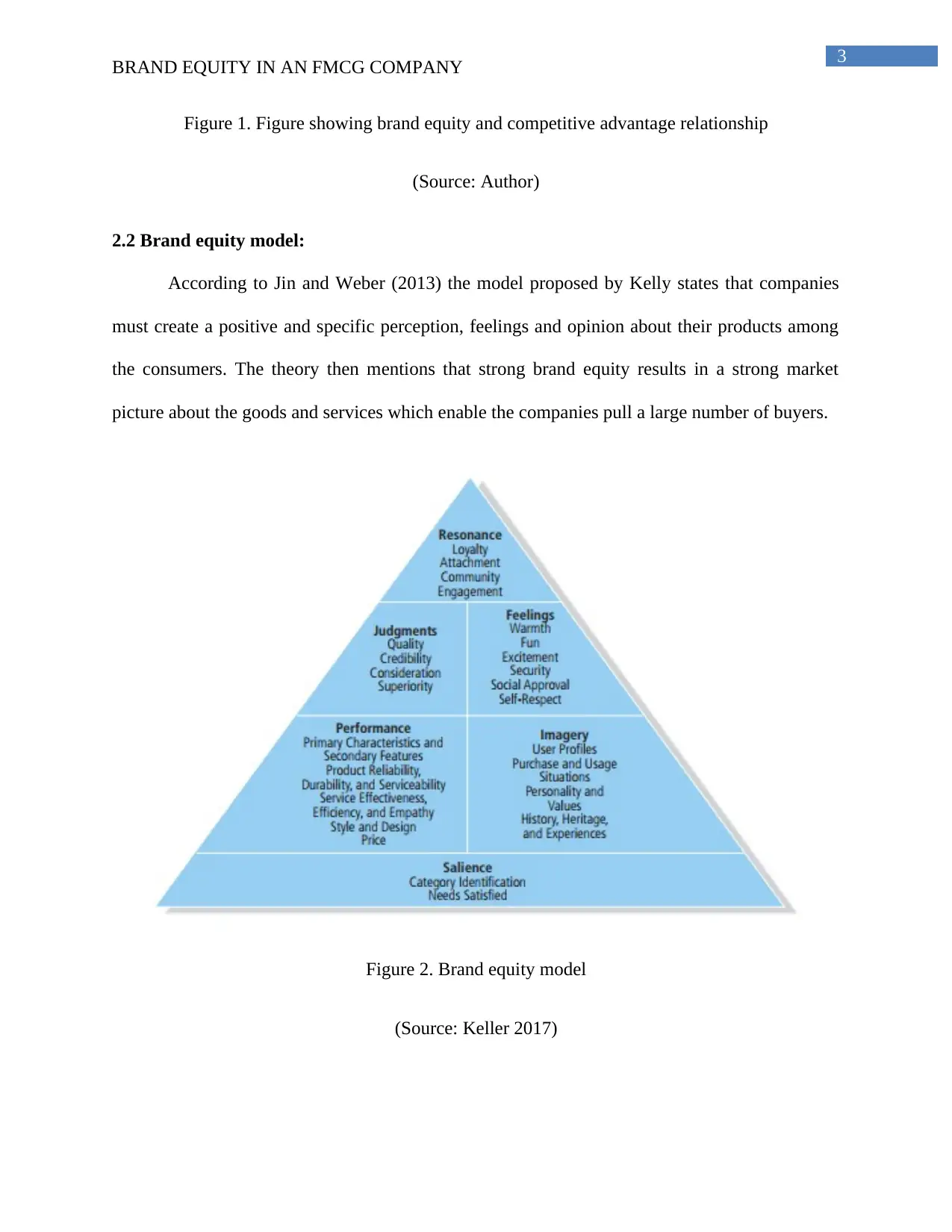
3
BRAND EQUITY IN AN FMCG COMPANY
Figure 1. Figure showing brand equity and competitive advantage relationship
(Source: Author)
2.2 Brand equity model:
According to Jin and Weber (2013) the model proposed by Kelly states that companies
must create a positive and specific perception, feelings and opinion about their products among
the consumers. The theory then mentions that strong brand equity results in a strong market
picture about the goods and services which enable the companies pull a large number of buyers.
Figure 2. Brand equity model
(Source: Keller 2017)
BRAND EQUITY IN AN FMCG COMPANY
Figure 1. Figure showing brand equity and competitive advantage relationship
(Source: Author)
2.2 Brand equity model:
According to Jin and Weber (2013) the model proposed by Kelly states that companies
must create a positive and specific perception, feelings and opinion about their products among
the consumers. The theory then mentions that strong brand equity results in a strong market
picture about the goods and services which enable the companies pull a large number of buyers.
Figure 2. Brand equity model
(Source: Keller 2017)
Paraphrase This Document
Need a fresh take? Get an instant paraphrase of this document with our AI Paraphraser
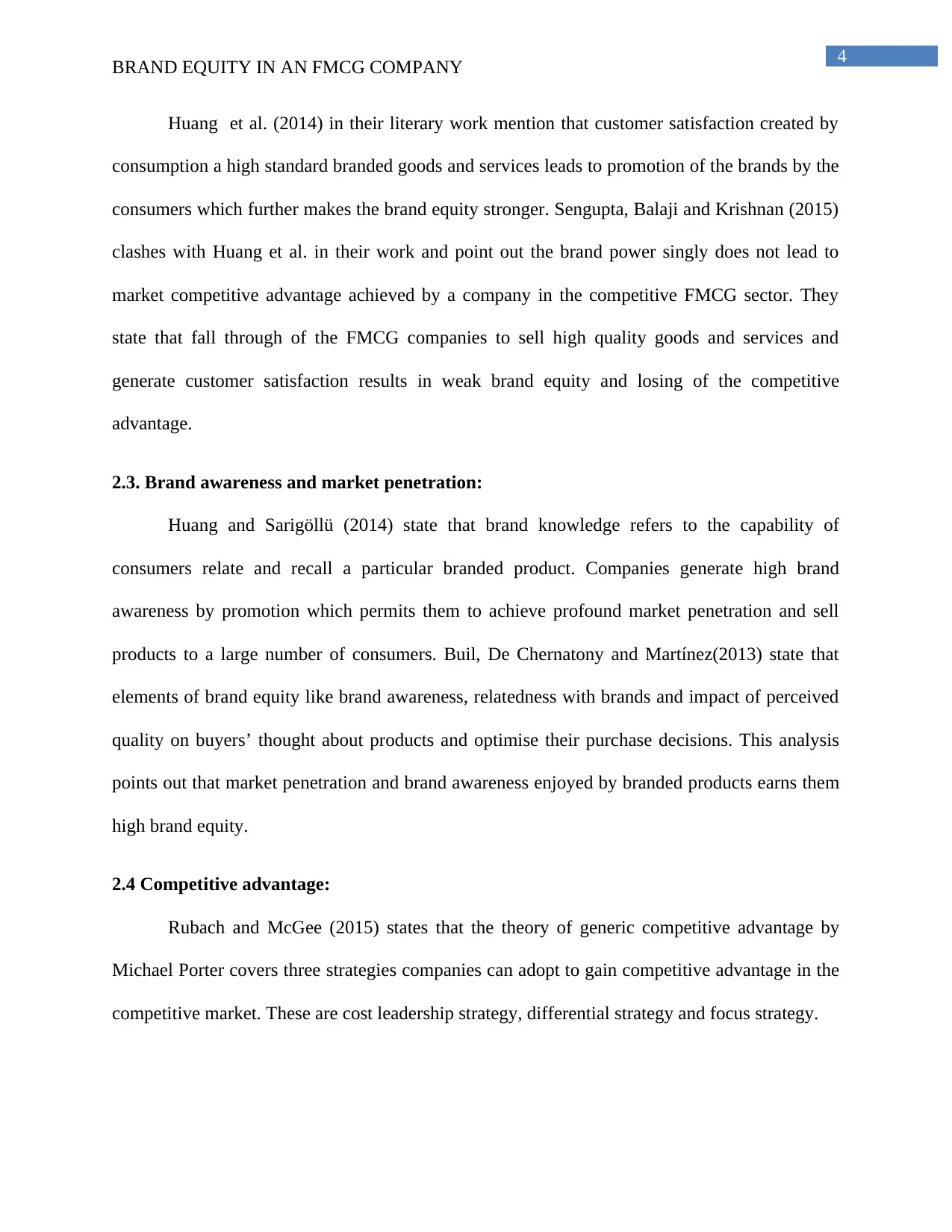
4
BRAND EQUITY IN AN FMCG COMPANY
Huang et al. (2014) in their literary work mention that customer satisfaction created by
consumption a high standard branded goods and services leads to promotion of the brands by the
consumers which further makes the brand equity stronger. Sengupta, Balaji and Krishnan (2015)
clashes with Huang et al. in their work and point out the brand power singly does not lead to
market competitive advantage achieved by a company in the competitive FMCG sector. They
state that fall through of the FMCG companies to sell high quality goods and services and
generate customer satisfaction results in weak brand equity and losing of the competitive
advantage.
2.3. Brand awareness and market penetration:
Huang and Sarigöllü (2014) state that brand knowledge refers to the capability of
consumers relate and recall a particular branded product. Companies generate high brand
awareness by promotion which permits them to achieve profound market penetration and sell
products to a large number of consumers. Buil, De Chernatony and Martínez(2013) state that
elements of brand equity like brand awareness, relatedness with brands and impact of perceived
quality on buyers’ thought about products and optimise their purchase decisions. This analysis
points out that market penetration and brand awareness enjoyed by branded products earns them
high brand equity.
2.4 Competitive advantage:
Rubach and McGee (2015) states that the theory of generic competitive advantage by
Michael Porter covers three strategies companies can adopt to gain competitive advantage in the
competitive market. These are cost leadership strategy, differential strategy and focus strategy.
BRAND EQUITY IN AN FMCG COMPANY
Huang et al. (2014) in their literary work mention that customer satisfaction created by
consumption a high standard branded goods and services leads to promotion of the brands by the
consumers which further makes the brand equity stronger. Sengupta, Balaji and Krishnan (2015)
clashes with Huang et al. in their work and point out the brand power singly does not lead to
market competitive advantage achieved by a company in the competitive FMCG sector. They
state that fall through of the FMCG companies to sell high quality goods and services and
generate customer satisfaction results in weak brand equity and losing of the competitive
advantage.
2.3. Brand awareness and market penetration:
Huang and Sarigöllü (2014) state that brand knowledge refers to the capability of
consumers relate and recall a particular branded product. Companies generate high brand
awareness by promotion which permits them to achieve profound market penetration and sell
products to a large number of consumers. Buil, De Chernatony and Martínez(2013) state that
elements of brand equity like brand awareness, relatedness with brands and impact of perceived
quality on buyers’ thought about products and optimise their purchase decisions. This analysis
points out that market penetration and brand awareness enjoyed by branded products earns them
high brand equity.
2.4 Competitive advantage:
Rubach and McGee (2015) states that the theory of generic competitive advantage by
Michael Porter covers three strategies companies can adopt to gain competitive advantage in the
competitive market. These are cost leadership strategy, differential strategy and focus strategy.
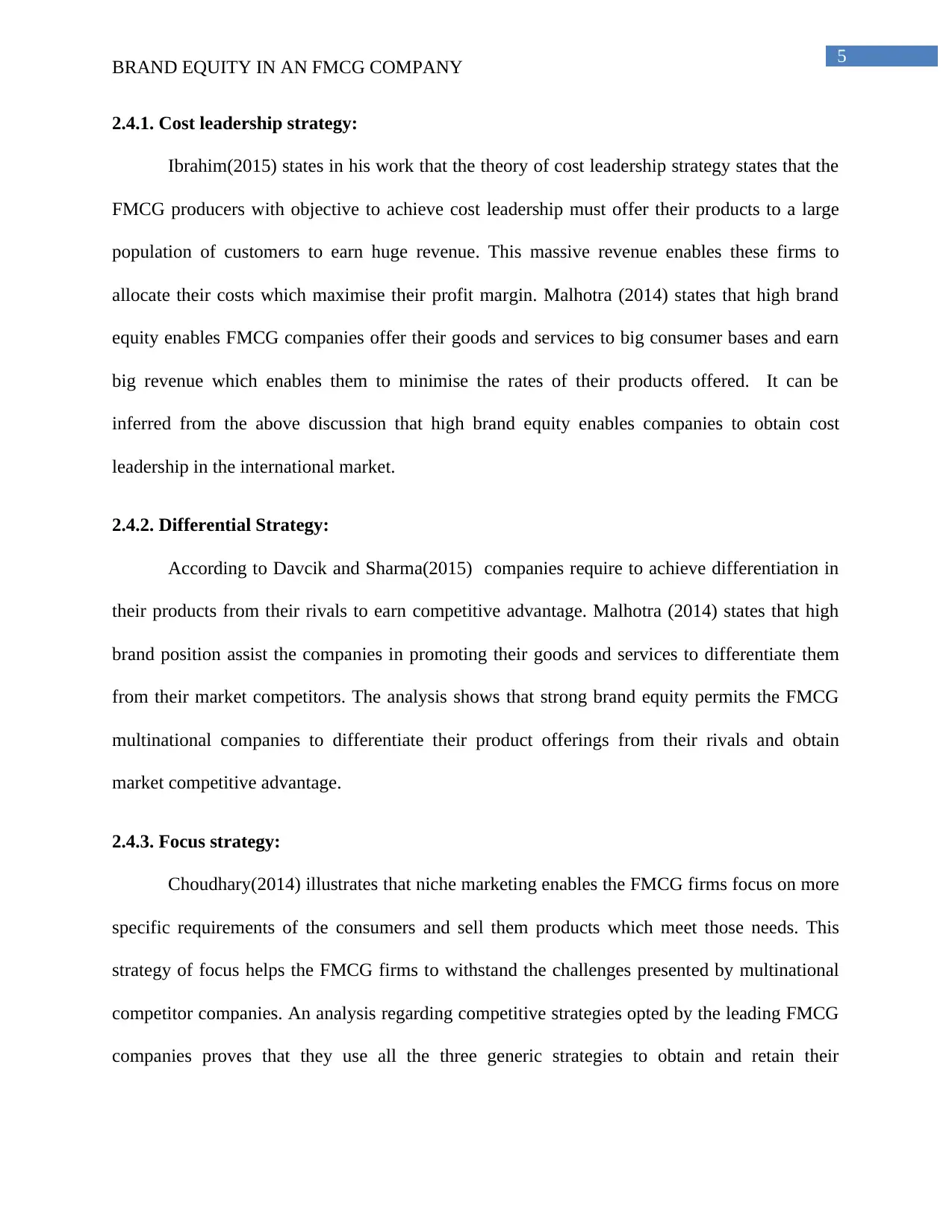
5
BRAND EQUITY IN AN FMCG COMPANY
2.4.1. Cost leadership strategy:
Ibrahim(2015) states in his work that the theory of cost leadership strategy states that the
FMCG producers with objective to achieve cost leadership must offer their products to a large
population of customers to earn huge revenue. This massive revenue enables these firms to
allocate their costs which maximise their profit margin. Malhotra (2014) states that high brand
equity enables FMCG companies offer their goods and services to big consumer bases and earn
big revenue which enables them to minimise the rates of their products offered. It can be
inferred from the above discussion that high brand equity enables companies to obtain cost
leadership in the international market.
2.4.2. Differential Strategy:
According to Davcik and Sharma(2015) companies require to achieve differentiation in
their products from their rivals to earn competitive advantage. Malhotra (2014) states that high
brand position assist the companies in promoting their goods and services to differentiate them
from their market competitors. The analysis shows that strong brand equity permits the FMCG
multinational companies to differentiate their product offerings from their rivals and obtain
market competitive advantage.
2.4.3. Focus strategy:
Choudhary(2014) illustrates that niche marketing enables the FMCG firms focus on more
specific requirements of the consumers and sell them products which meet those needs. This
strategy of focus helps the FMCG firms to withstand the challenges presented by multinational
competitor companies. An analysis regarding competitive strategies opted by the leading FMCG
companies proves that they use all the three generic strategies to obtain and retain their
BRAND EQUITY IN AN FMCG COMPANY
2.4.1. Cost leadership strategy:
Ibrahim(2015) states in his work that the theory of cost leadership strategy states that the
FMCG producers with objective to achieve cost leadership must offer their products to a large
population of customers to earn huge revenue. This massive revenue enables these firms to
allocate their costs which maximise their profit margin. Malhotra (2014) states that high brand
equity enables FMCG companies offer their goods and services to big consumer bases and earn
big revenue which enables them to minimise the rates of their products offered. It can be
inferred from the above discussion that high brand equity enables companies to obtain cost
leadership in the international market.
2.4.2. Differential Strategy:
According to Davcik and Sharma(2015) companies require to achieve differentiation in
their products from their rivals to earn competitive advantage. Malhotra (2014) states that high
brand position assist the companies in promoting their goods and services to differentiate them
from their market competitors. The analysis shows that strong brand equity permits the FMCG
multinational companies to differentiate their product offerings from their rivals and obtain
market competitive advantage.
2.4.3. Focus strategy:
Choudhary(2014) illustrates that niche marketing enables the FMCG firms focus on more
specific requirements of the consumers and sell them products which meet those needs. This
strategy of focus helps the FMCG firms to withstand the challenges presented by multinational
competitor companies. An analysis regarding competitive strategies opted by the leading FMCG
companies proves that they use all the three generic strategies to obtain and retain their
⊘ This is a preview!⊘
Do you want full access?
Subscribe today to unlock all pages.

Trusted by 1+ million students worldwide
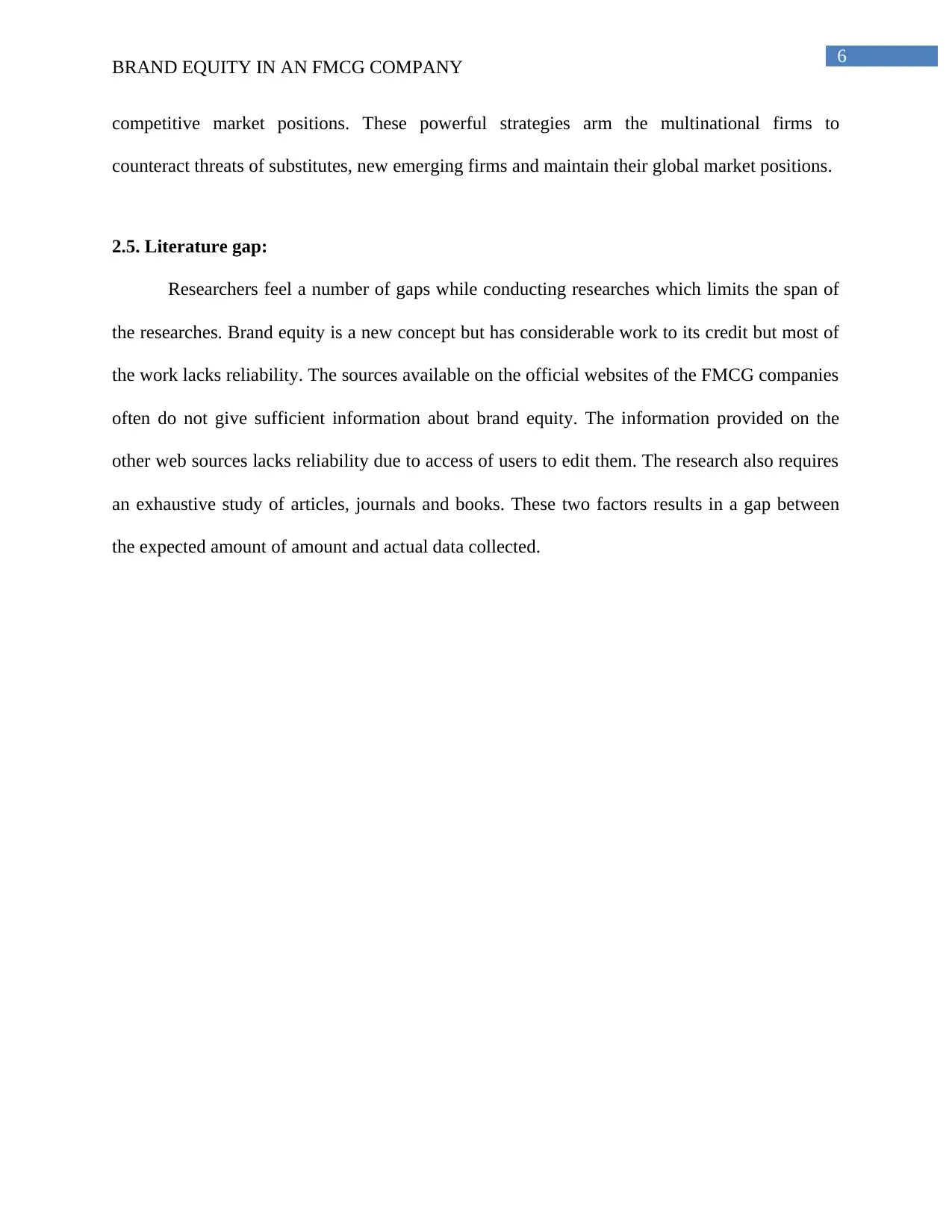
6
BRAND EQUITY IN AN FMCG COMPANY
competitive market positions. These powerful strategies arm the multinational firms to
counteract threats of substitutes, new emerging firms and maintain their global market positions.
2.5. Literature gap:
Researchers feel a number of gaps while conducting researches which limits the span of
the researches. Brand equity is a new concept but has considerable work to its credit but most of
the work lacks reliability. The sources available on the official websites of the FMCG companies
often do not give sufficient information about brand equity. The information provided on the
other web sources lacks reliability due to access of users to edit them. The research also requires
an exhaustive study of articles, journals and books. These two factors results in a gap between
the expected amount of amount and actual data collected.
BRAND EQUITY IN AN FMCG COMPANY
competitive market positions. These powerful strategies arm the multinational firms to
counteract threats of substitutes, new emerging firms and maintain their global market positions.
2.5. Literature gap:
Researchers feel a number of gaps while conducting researches which limits the span of
the researches. Brand equity is a new concept but has considerable work to its credit but most of
the work lacks reliability. The sources available on the official websites of the FMCG companies
often do not give sufficient information about brand equity. The information provided on the
other web sources lacks reliability due to access of users to edit them. The research also requires
an exhaustive study of articles, journals and books. These two factors results in a gap between
the expected amount of amount and actual data collected.
Paraphrase This Document
Need a fresh take? Get an instant paraphrase of this document with our AI Paraphraser
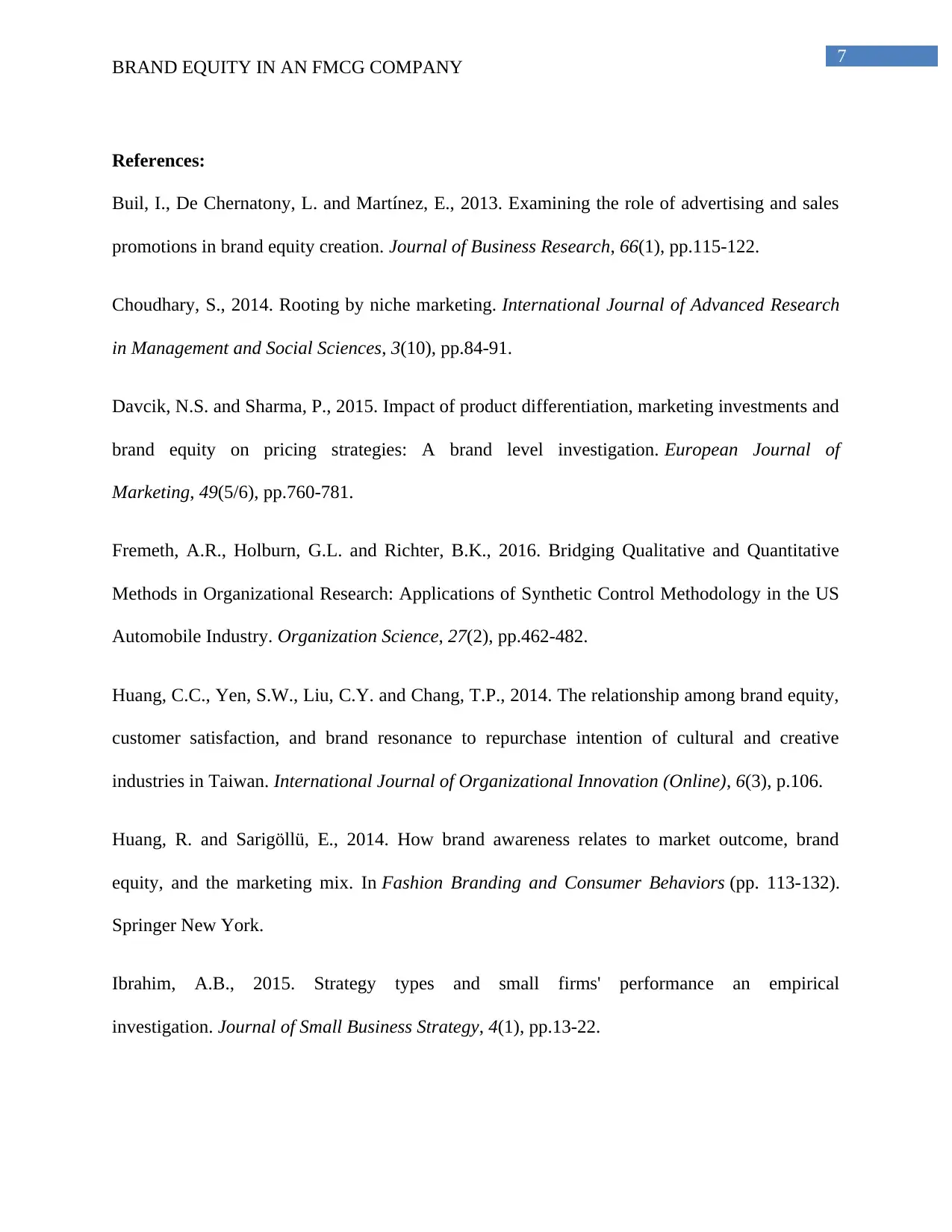
7
BRAND EQUITY IN AN FMCG COMPANY
References:
Buil, I., De Chernatony, L. and Martínez, E., 2013. Examining the role of advertising and sales
promotions in brand equity creation. Journal of Business Research, 66(1), pp.115-122.
Choudhary, S., 2014. Rooting by niche marketing. International Journal of Advanced Research
in Management and Social Sciences, 3(10), pp.84-91.
Davcik, N.S. and Sharma, P., 2015. Impact of product differentiation, marketing investments and
brand equity on pricing strategies: A brand level investigation. European Journal of
Marketing, 49(5/6), pp.760-781.
Fremeth, A.R., Holburn, G.L. and Richter, B.K., 2016. Bridging Qualitative and Quantitative
Methods in Organizational Research: Applications of Synthetic Control Methodology in the US
Automobile Industry. Organization Science, 27(2), pp.462-482.
Huang, C.C., Yen, S.W., Liu, C.Y. and Chang, T.P., 2014. The relationship among brand equity,
customer satisfaction, and brand resonance to repurchase intention of cultural and creative
industries in Taiwan. International Journal of Organizational Innovation (Online), 6(3), p.106.
Huang, R. and Sarigöllü, E., 2014. How brand awareness relates to market outcome, brand
equity, and the marketing mix. In Fashion Branding and Consumer Behaviors (pp. 113-132).
Springer New York.
Ibrahim, A.B., 2015. Strategy types and small firms' performance an empirical
investigation. Journal of Small Business Strategy, 4(1), pp.13-22.
BRAND EQUITY IN AN FMCG COMPANY
References:
Buil, I., De Chernatony, L. and Martínez, E., 2013. Examining the role of advertising and sales
promotions in brand equity creation. Journal of Business Research, 66(1), pp.115-122.
Choudhary, S., 2014. Rooting by niche marketing. International Journal of Advanced Research
in Management and Social Sciences, 3(10), pp.84-91.
Davcik, N.S. and Sharma, P., 2015. Impact of product differentiation, marketing investments and
brand equity on pricing strategies: A brand level investigation. European Journal of
Marketing, 49(5/6), pp.760-781.
Fremeth, A.R., Holburn, G.L. and Richter, B.K., 2016. Bridging Qualitative and Quantitative
Methods in Organizational Research: Applications of Synthetic Control Methodology in the US
Automobile Industry. Organization Science, 27(2), pp.462-482.
Huang, C.C., Yen, S.W., Liu, C.Y. and Chang, T.P., 2014. The relationship among brand equity,
customer satisfaction, and brand resonance to repurchase intention of cultural and creative
industries in Taiwan. International Journal of Organizational Innovation (Online), 6(3), p.106.
Huang, R. and Sarigöllü, E., 2014. How brand awareness relates to market outcome, brand
equity, and the marketing mix. In Fashion Branding and Consumer Behaviors (pp. 113-132).
Springer New York.
Ibrahim, A.B., 2015. Strategy types and small firms' performance an empirical
investigation. Journal of Small Business Strategy, 4(1), pp.13-22.
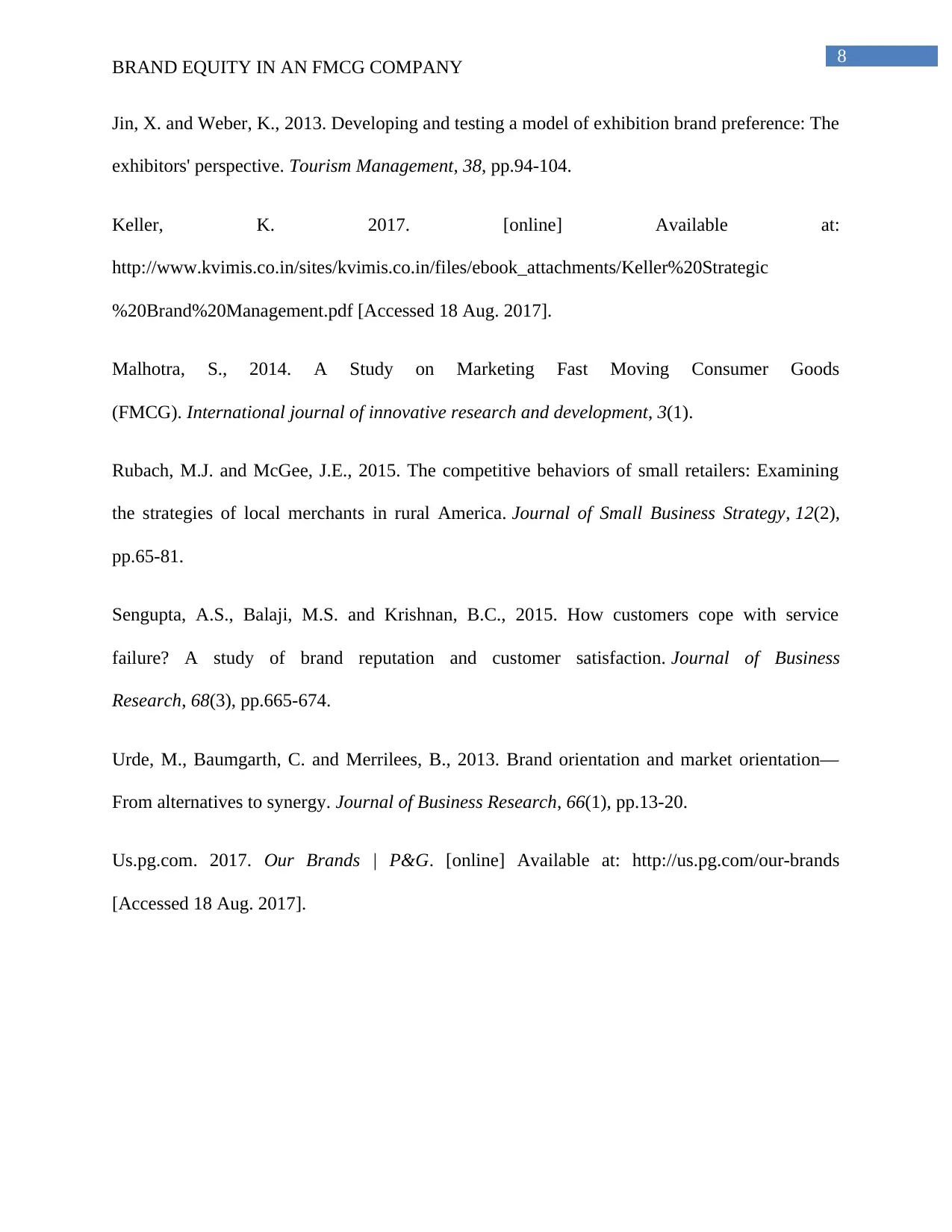
8
BRAND EQUITY IN AN FMCG COMPANY
Jin, X. and Weber, K., 2013. Developing and testing a model of exhibition brand preference: The
exhibitors' perspective. Tourism Management, 38, pp.94-104.
Keller, K. 2017. [online] Available at:
http://www.kvimis.co.in/sites/kvimis.co.in/files/ebook_attachments/Keller%20Strategic
%20Brand%20Management.pdf [Accessed 18 Aug. 2017].
Malhotra, S., 2014. A Study on Marketing Fast Moving Consumer Goods
(FMCG). International journal of innovative research and development, 3(1).
Rubach, M.J. and McGee, J.E., 2015. The competitive behaviors of small retailers: Examining
the strategies of local merchants in rural America. Journal of Small Business Strategy, 12(2),
pp.65-81.
Sengupta, A.S., Balaji, M.S. and Krishnan, B.C., 2015. How customers cope with service
failure? A study of brand reputation and customer satisfaction. Journal of Business
Research, 68(3), pp.665-674.
Urde, M., Baumgarth, C. and Merrilees, B., 2013. Brand orientation and market orientation—
From alternatives to synergy. Journal of Business Research, 66(1), pp.13-20.
Us.pg.com. 2017. Our Brands | P&G. [online] Available at: http://us.pg.com/our-brands
[Accessed 18 Aug. 2017].
BRAND EQUITY IN AN FMCG COMPANY
Jin, X. and Weber, K., 2013. Developing and testing a model of exhibition brand preference: The
exhibitors' perspective. Tourism Management, 38, pp.94-104.
Keller, K. 2017. [online] Available at:
http://www.kvimis.co.in/sites/kvimis.co.in/files/ebook_attachments/Keller%20Strategic
%20Brand%20Management.pdf [Accessed 18 Aug. 2017].
Malhotra, S., 2014. A Study on Marketing Fast Moving Consumer Goods
(FMCG). International journal of innovative research and development, 3(1).
Rubach, M.J. and McGee, J.E., 2015. The competitive behaviors of small retailers: Examining
the strategies of local merchants in rural America. Journal of Small Business Strategy, 12(2),
pp.65-81.
Sengupta, A.S., Balaji, M.S. and Krishnan, B.C., 2015. How customers cope with service
failure? A study of brand reputation and customer satisfaction. Journal of Business
Research, 68(3), pp.665-674.
Urde, M., Baumgarth, C. and Merrilees, B., 2013. Brand orientation and market orientation—
From alternatives to synergy. Journal of Business Research, 66(1), pp.13-20.
Us.pg.com. 2017. Our Brands | P&G. [online] Available at: http://us.pg.com/our-brands
[Accessed 18 Aug. 2017].
⊘ This is a preview!⊘
Do you want full access?
Subscribe today to unlock all pages.

Trusted by 1+ million students worldwide
1 out of 9
Related Documents
Your All-in-One AI-Powered Toolkit for Academic Success.
+13062052269
info@desklib.com
Available 24*7 on WhatsApp / Email
![[object Object]](/_next/static/media/star-bottom.7253800d.svg)
Unlock your academic potential
Copyright © 2020–2025 A2Z Services. All Rights Reserved. Developed and managed by ZUCOL.





